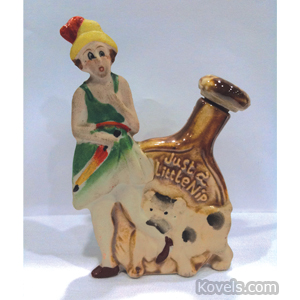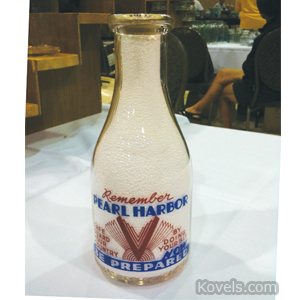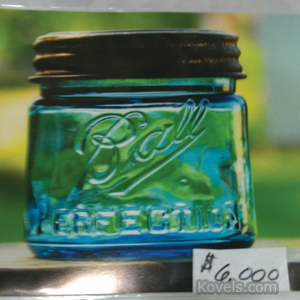The convention of the Federation of Historical Bottle Collectors was in Ohio in 2010. There were lectures, exhibits of collections—from ink bottles to battery jars to jelly jars—and lots of dealers and collectors. It’s a very friendly group. Many are “bottle friends” who meet mainly at the shows. I finally met many authors and collectors I have known only by name during my years of bottle collecting.
Ralph and I bought food bottles, preferably with the paper label still in place. The major collectors want flasks, bitters, sodas, inks, fruit jars, milk bottles and whiskies. I photographed a few of the bottles that interested me but bought only one: a full, labeled Eilert’s Waldhäuser Magen Stomach Bitters for $125. It was from my hometown and I will eventually give it to the local historical society. As usual, a few people thought I should buy the Kowel’s Beverages soda bottle with the pyro label, but I already have one.
We have a number of small “nips,” comic ceramic bottles that hold a single shot of whiskey. A “Just a Little Nip” lady bottle marked $60 was similar to one I own.
A dealer from Australia was at the show with some unfamiliar bottles from his country. He had a Warner’s Safe Cure bottle with the added word “Melbourne” embossed on it.
Milk bottle caps as well as milk bottles were selling. Caps started at 25 cents and were available at low prices. I liked a cap that said “Keep on Flying.” A rare milk bottle with a pyro label saying “Remember Pearl Harbor” was expensive, $1,055. In fact, all the bottles and go-withs made during the war years (1941-45) were priced high, probably because they’re wanted by World War II veterans—and the slogans make them easy to date. But beware: fakes are being made.
Interesting and inexpensive, at $15, were limited edition multicolored Mountain Dew bottles from 2007 and 2008. An attractive “go-with” was an early tin “Dr. Pepper, King of Beverages” advertising tray decorated with roses, but at $700 I walked by. A Chinese redware teapot interested me, too. We have several, but this one had an ad for “WK Bell, Up to Date Grocer, Eugene, Oregon” pressed into a clay banner. The pots were made to order in China in the early 1900s, then were sent to Oregon. But rarest of all was a group of half-pint fruit jars: a Ball Perfection jar was priced $6,000; a Mason, $15,000; and a Woodbury Improved, $15,000.
A word of warning: We saw some reproduction tops for fruit jars that were made as early as the 1970s. Serious collectors can spot them, but a beginning collector should ask about any “rare” tin top. It adds a lot to the value of a jar to have the proper liner and screw lid.
For fun we looked for the largest bottle at the show. It was a tie between two 28-inch bottles: a stoneware ink bottle for $1,700 and an amber POC beer bottle for $45.






Leave a Reply
You must be logged in to post a comment.